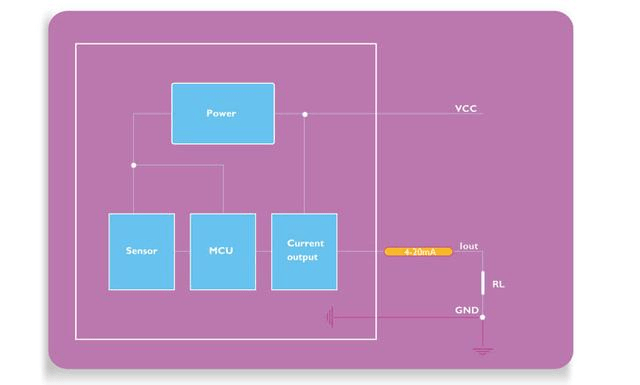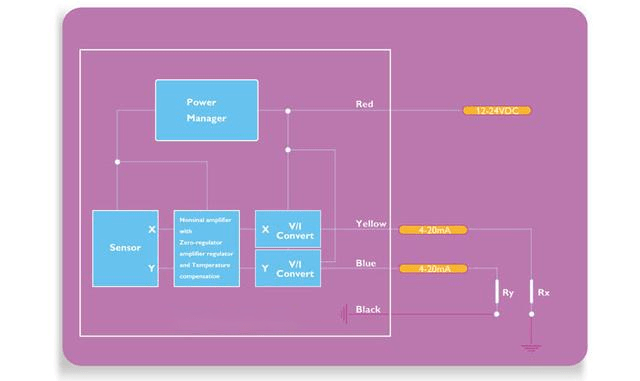The output mode of the tilt sensor is divided into two types, one refers to the physical output mode, and the other is only the electrical output mode.
How many kinds of physical output modes are there for tilt sensors?
Usually there is a cable output, connector output. Cable output depends on the length, see the color identification. Connector output, pay attention to the number of cores, and pin definition.
What is the electrical output mode of the tilt sensor?
The electrical output mode is relative to the physical output mode, mainly refers to the electrical connection mode of the following bit machine, which is divided into many kinds, the largest is divided into two categories, that is, analog output and digital output.
What is an analog output tilt sensor?
Analog line output means that the output signal is an analog signal, such as voltage output, current output.
1. Voltage output
It is usually 0~5v output, there are also 0.5~4.5v output, and 0~10V output, most of the cases are 0~5V output mode. As far as the current understanding of the situation is concerned, if the upper computer is a PLC controller of Siemens, it may be limited by the shortage or limitation of interface resources, and will use 0~10V output, which will be encountered in the photovoltaic industry. Why develop a 0.5~4.5Vdc output? In special cases, the user wants to determine whether the sensor is normal, if you see 0~0.5V voltage output on the display, as a reference for troubleshooting, you will use 0.5~4.5V output inclination sensor. For example, the ER-TS-3160VO is a single-axis tilt sensor with analog voltage output, and the user only needs to collect the voltage value of the sensor to calculate the tilt angle of the current object. The built-in (MEMS) solid pendulum measures changes in the static gravity field, converts them into changes in inclination, and outputs them via voltage (0~10V, 0.5~4.5V, 0~5V optional).
How many lines are the inclination sensors with voltage output? Single-axis inclination sensor for voltage output: power supply +, power supply -, voltage output 1 way, is three-wire system; For dual-axis voltage output inclination sensor: power supply +, power supply -, voltage output 2, is a four-wire system.
2. Current output
4~20mA output used to be more common, belongs to the more traditional, because the digital circuit is not very popular, but in the last 20 years, the digital circuit has long been popular, so this form is slowly no longer useful, but considering that some controllers, upper computers, secondary instruments and so on have such interfaces, so there are still customers choose this interface, This is the reason for the historical transition, but 4 to 20mA has an advantage, that is, the transmission distance is far, unlike the voltage output, after a longer cable, the signal attenuation is larger.
Although the voltage at the output end is unchanged, the longer the cable, the smaller the voltage to the load end, and the current type output end is the same as the load end, it is impossible to change. Therefore, when your upper computer is more than 50 meters away from the sensor, in order to ensure the stability and reliability of the signal, the output of 4~20mA is one of the choices. The ER-TS-3168CU is a standard industrial current output single-axis tilt sensor that can transmit over a considerable distance, up to 2,000 meters away.
For the inclination sensor with current type output, what is the two-wire system and what is the three-wire system? Look at the following figure, very intuitive, at a glance, Figure 1 is a two-wire system, Figure 2 is a three-wire system. Single-axis two-wire system, two-axis three-wire system, pay attention to the load resistance when in use do not ignore.


What is a digital output tilt sensor?
Digital output is relative to analog, there are many kinds of digital interfaces, such as RS232,TTL, RS485, CAN, PWM, and very rare RS422 interface, SII interface, and other master-slave communication methods. ER-TS-4156DI is a digital single-axis tilt sensor, its output mode has RS232, RS485 or TTL, MODBUS level interface options, it can resist external electromagnetic interference, adapt to harsh industrial environment for long-term work, is an ideal choice for industrial automation control and platform attitude measurement.

.jpg)

No comments:
Post a Comment